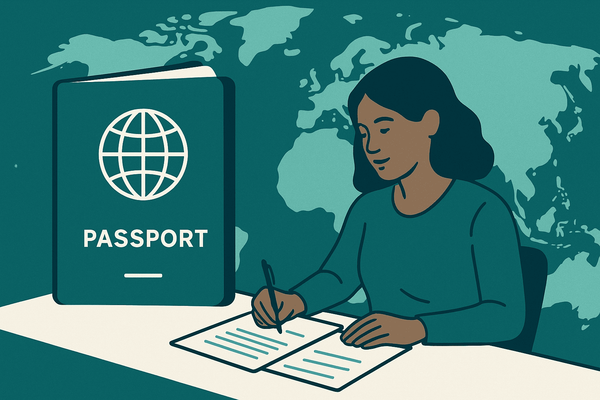How many US expats are there?

Did you know that millions of US citizens don’t live in the United States? Whether they’re working, studying, retiring, or just exploring the world, many U.S. citizens have chosen to call another country home.
It’s estimated that over 9 million Americans live abroad today. Some settle down permanently, while others spend just a few years before returning. Their reasons vary—some are seeking better job opportunities, a lower cost of living, or a new adventure. Others move for love, family, or education.
In this article, we’ll dive into the numbers behind this global migration. We’ll explore where Americans are moving, why they choose to leave, and how their presence impacts both their new and old homes.
Historical background
Americans moving abroad isn't a new trend—it has been happening for centuries! While today's expats might be digital nomads or retirees looking for a cheaper lifestyle, the reasons people left the U.S. in the past were quite different. Let's take a quick look at how American migration has changed over time.
Early waves of American emigration
In the 19th century, Americans began moving abroad for gold, trade, and exploration. Some traveled to California’s Gold Rush, but others went even further—to places like Australia and South America—in search of fortune. Missionaries, diplomats, and traders also started settling in foreign lands, bringing American culture with them.
After the Civil War, many freed African Americans left the U.S. to start new lives. Some moved to Liberia, a country in West Africa founded by freed slaves, hoping for better opportunities than they had in the U.S.
Post-war relocations & global influence
By the 20th century, American migration was often tied to war and politics. After World War II, many U.S. soldiers stayed in Europe or Asia after being stationed there. Marrying locals, working for international companies, or helping with rebuilding efforts kept them abroad.
During the Cold War, Americans moved overseas for diplomatic and business reasons, working in embassies, military bases, or multinational corporations. Some also left for political reasons—artists, writers, and intellectuals sometimes felt more freedom in countries like France and Mexico.
Modern globalization & migration
Fast forward to today, and American migration is more common than ever. Thanks to the internet, cheaper flights, and remote work, more people have the freedom to move abroad. Some do it for adventure, others for financial reasons. The motivations have changed, but the desire to explore the world remains the same.
Millions of Americans live outside the United States, but tracking the exact number is difficult. Many U.S. citizens abroad don’t register with embassies, and countries have different ways of counting foreign residents. However, several organizations provide estimates that help us understand how many Americans live abroad, who they are, and how long they tend to stay.
Current overview
How many Americans live abroad?
- Association of Americans Resident Overseas (AARO): As of October 2024, AARO estimates that approximately 5.5 million U.S. citizens live abroad.
- Federal Voting Assistance Program (FVAP): In 2022, FVAP estimated that about 4.4 million U.S. citizens resided overseas, with 2.8 million of them eligible to vote.
These numbers vary because counting Americans abroad is tricky. Many don’t register with the government, and some hold dual citizenship, making them harder to track.
Who are these Americans?
Americans living abroad come from all walks of life. Some are young professionals working remotely or for multinational companies. Others are retirees looking for a lower cost of living. Many are students, military personnel, or people who moved for personal reasons like marriage.
Age groups of Americans abroad
The age distribution of Americans abroad is as follows:
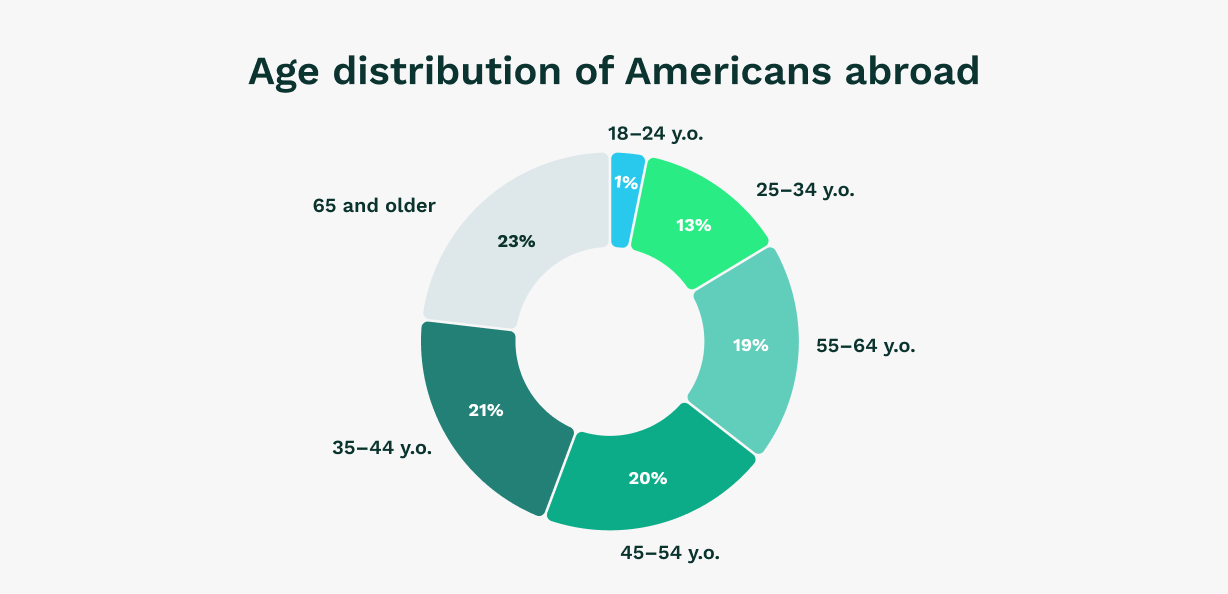
- 18–24 years old: 1%
- 25–34 years old: 13%
- 35–44 years old: 21%
- 45–54 years old: 20%
- 55–64 years old: 19%
- 65 and older: 23%
The data shows that most American expats are either mid-career professionals (35–54) or retirees (65+). Younger Americans (18–24) make up a small percentage, likely due to work and financial limitations.
Education & income of Americans living abroad
American expats tend to be highly educated compared to the general U.S. population. A large percentage hold advanced degrees, which helps explain their career opportunities and income levels abroad.
Education levels of American expats

- Bachelor’s Degree: 41%
- Master’s Degree or Postgraduate Education: 44%
- PhD: 9%
This means that over 90% of Americans living abroad have at least a bachelor’s degree, significantly higher than the general U.S. population, where only 48.1% of people over 25 hold an associate degree or higher.
Income levels of American expats
- 66% of Americans abroad earn less than $75,000 per year.
- 47% have aggregate bank balances of less than $50,000.
- Many American expats work in high-paying industries like finance, tech, and education.
- Others rely on retirement savings, pensions, or Social Security, especially those living in countries with a lower cost of living.
While there is no single average income figure for all U.S. expats, those with master’s degrees or higher tend to earn a median salary of around $80,200 per year in the U.S. It is reasonable to assume that many Americans abroad earn similar or higher salaries, depending on their country of residence.
How long do Americans stay abroad?
The amount of time Americans spend living outside the U.S. varies widely. Some move for a short period, while others settle permanently.
Duration of stay
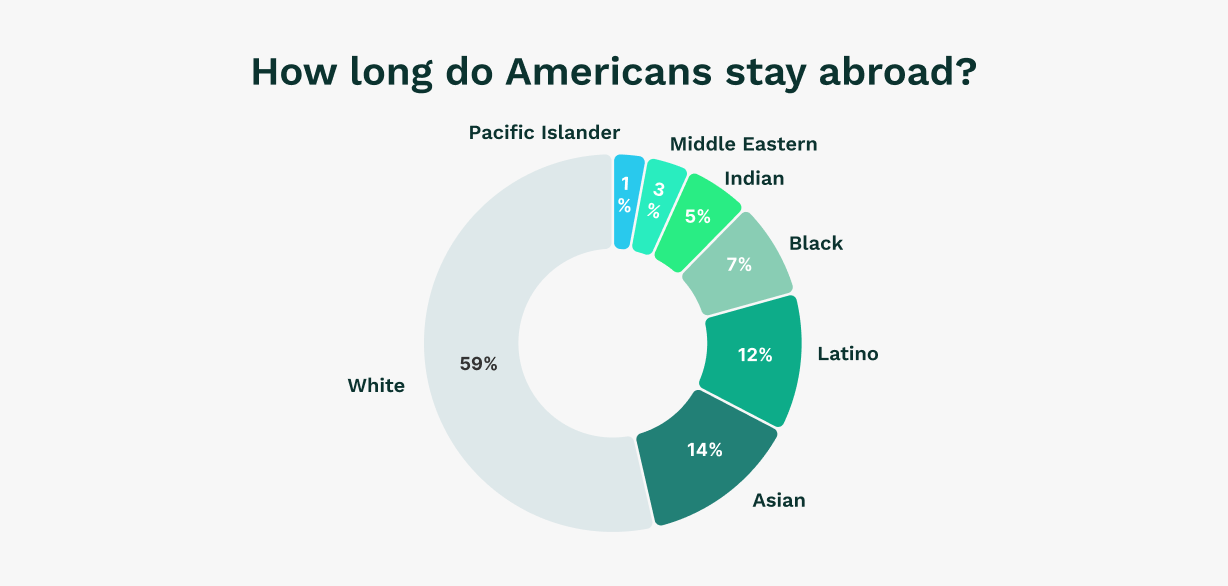
- 66% of Americans abroad have lived outside the U.S. for more than 10 years.
- 17% of Americans abroad left the U.S. before the age of 21.
Short-term (Less than 1 year):
- Around 10% of American expats have been abroad for less than six months.
- Common for students, temporary work assignments, or trial periods before committing to a long-term move.
Medium-term (1–5 years):
- Many Americans go abroad for job contracts, study programs, or military assignments that last a few years.
- This category includes those working for multinational companies or completing graduate degrees.
Long-term (More than 5 years):
- A large percentage of American expats remain abroad for extended periods.
- 44% of American expats say they plan to stay overseas indefinitely.
Permanent residents & retirees:
- Many older expats obtain permanent residency or dual citizenship.
- Retirees often choose countries with affordable healthcare, good climate, and friendly visa policies.
- About 23% of Americans living abroad are retirees.
Geographic distribution of Americans
The data presented in this section is based on estimates from 2020 and represents a lower-bound approximation of the total number of American emigrants.
The distribution of Americans abroad varies significantly by region, with certain areas hosting large expatriate communities due to economic, cultural, and historical ties.
Below is the data on the total number of Americans living in different regions worldwide:
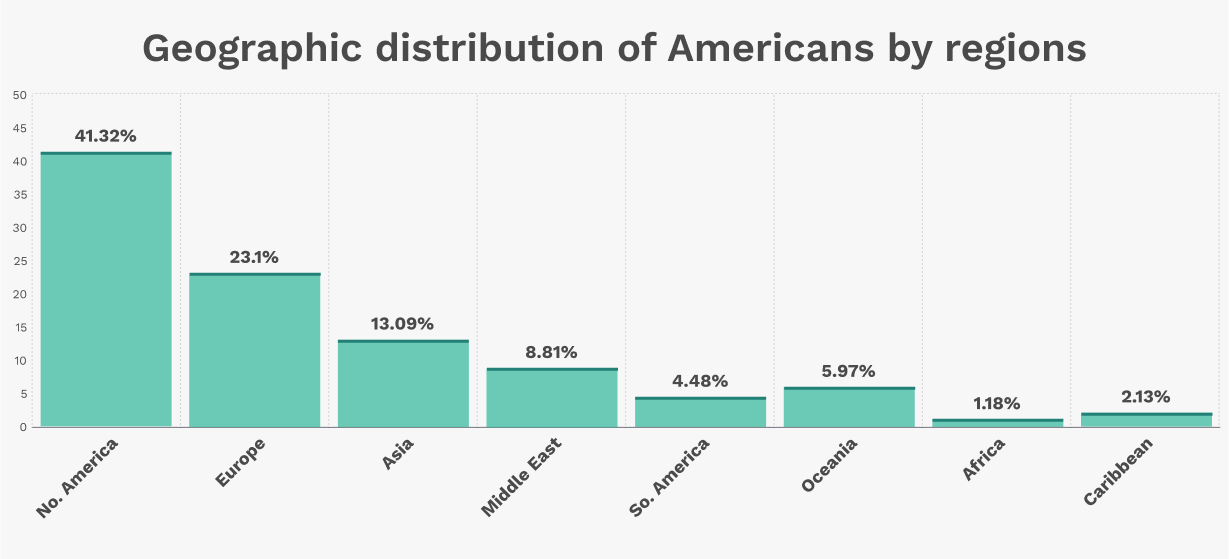
| Region | Total Americans Abroad | Percentage of Total |
|---|---|---|
| North America | 1,421,813 | 41.32% |
| Europe | 794,855 | 23.10% |
| Asia | 450,469 | 13.09% |
| Middle East | 303,484 | 8.81% |
| South America | 154,000 | 4.48% |
| Oceania | 205,473 | 5.97% |
| Africa | 40,539 | 1.18% |
| Caribbean | 73,209 | 2.13% |
Most popular destinations for Americans abroad
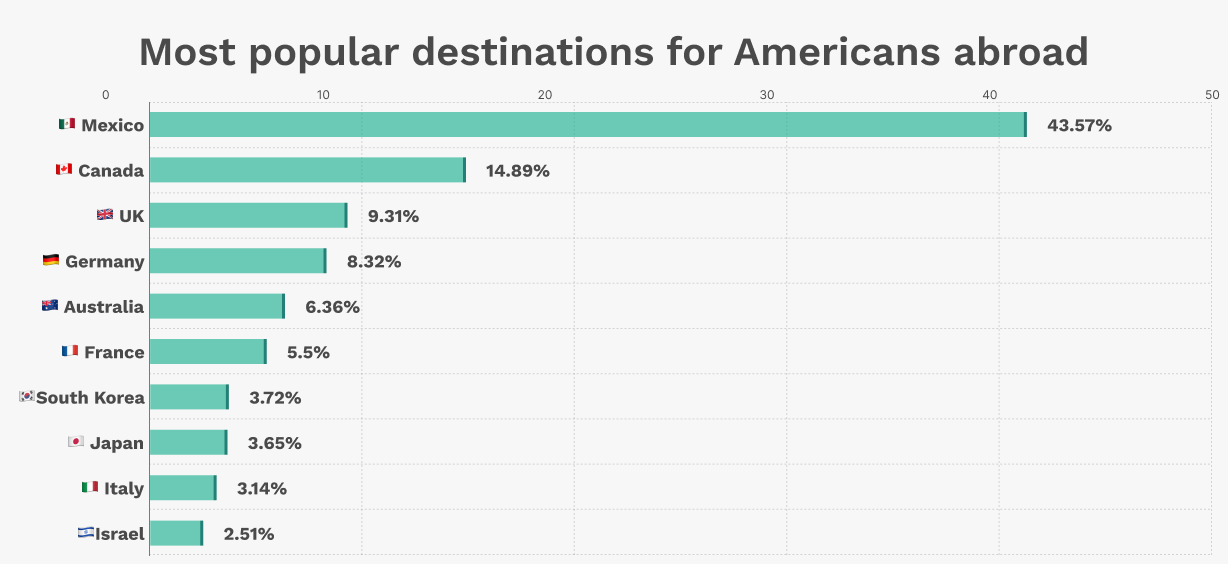
1. Mexico (799,248 emigrants, 43.57%)
As the most popular destination for American emigrants, Mexico attracts U.S. citizens for several key reasons:
- Proximity: Its close geographic location allows for easy travel back to the U.S.
- Cost of Living: Significantly lower than in the U.S., making it ideal for retirees and remote workers.
- Cultural & Historical Ties: Shared history and language learning opportunities draw Americans to regions with established expatriate communities.
- Popular Destinations: Cities like Mexico City, Guadalajara, and Mérida, as well as beach towns such as Puerto Vallarta and Playa del Carmen, are hotspots for Americans seeking a better quality of life.
2. Canada (273,226 emigrants, 14.89%)
Canada remains the second most popular destination for American expatriates, thanks to:
- Similar Culture & Language: As an English-speaking country with strong historical ties to the U.S., Canada provides a familiar cultural environment.
- Healthcare & Social Benefits: Universal healthcare and a high standard of living make it particularly attractive for families and retirees.
- Economic & Work Opportunities: The tech and finance industries in cities like Toronto, Vancouver, and Montreal continue to draw skilled American professionals.
3. United Kingdom (170,771 emigrants, 9.31%)
The United Kingdom has long been a favored destination for Americans, particularly those with European ancestral ties or professional aspirations in London. Key factors include:
- Historical & Linguistic Affinity: The shared language and deep-rooted cultural connections ease integration.
- Academic & Business Opportunities: The UK’s prestigious universities and thriving finance sector in London attract students and professionals alike.
- American Expatriate Hubs: London, Edinburgh, and Manchester are among the most common settlement areas for Americans.
4. Germany (152,639 emigrants, 8.32%)
Germany ranks fourth as a major destination for American emigrants, largely due to:
- Economic Strength: Germany's robust economy, particularly in engineering, automotive, and technology sectors, offers ample job opportunities.
- Quality of Life: With affordable healthcare, efficient public transport, and high safety standards, Germany appeals to families and professionals.
- Key Expatriate Cities: Berlin, Munich, and Frankfurt serve as top destinations for Americans, each offering a unique cultural and professional environment.
5. Australia (116,620 emigrants, 6.36%)
Australia remains an attractive choice for Americans looking for a high quality of life in an English-speaking country. Reasons for migration include:
- Job Opportunities & High Wages: Australia’s job market, especially in mining, tech, and finance, is lucrative.
- Cultural Similarities: Social norms, sports culture, and lifestyle align closely with those in the U.S.
- Major American Hubs: Sydney, Melbourne, and Brisbane host growing American communities.
6. France (100,933 emigrants, 5.50%)
France is a favorite among Americans seeking a European lifestyle rich in culture, cuisine, and history. Key attractions include:
- Cultural Prestige: Paris, known for its art, literature, and gourmet food, has long been an expatriate magnet.
- Education & Creative Industries: Many American students, writers, and filmmakers relocate to France for academic and artistic opportunities.
- Expatriate Hubs: Paris, Lyon, and the French Riviera are key areas where American expatriates settle.
7. South Korea (68,360 emigrants, 3.72%)
South Korea has seen a rise in American expatriates, particularly due to:
- Military & Defense Ties: A significant number of Americans move to South Korea due to U.S. military presence and defense-related jobs.
- Technology & Teaching Jobs: The demand for English teachers and tech professionals has grown in cities like Seoul and Busan.
- Cultural Appeal: The increasing global popularity of Korean entertainment (K-pop, dramas) has sparked interest in relocating to South Korea.
8. Japan (66,847 emigrants, 3.65%)
Japan continues to attract American expatriates for several key reasons:
- Corporate Relocations: Many American professionals work for multinational companies in Tokyo and Osaka.
- Teaching & Research Opportunities: The JET Program and various language schools recruit U.S. educators.
- Cultural Allure: The unique blend of traditional and modern culture makes Japan a fascinating place to live.
9. Italy (57,521 emigrants, 3.14%)
Italy is a top destination for Americans who appreciate its rich history, food, and Mediterranean lifestyle:
- Retirement & Dual Citizenship: Many Americans with Italian ancestry obtain dual citizenship and move to Italy for retirement.
- Tourism & Business Opportunities: The hospitality and fashion industries offer opportunities for entrepreneurs and creatives.
- Popular Settlements: Rome, Florence, and Milan host the largest American expatriate communities.
10. Israel (46,058 emigrants, 2.51%)
Israel rounds out the top 10, drawing American expatriates for:
- Religious & Cultural Ties: A large percentage of American emigrants in Israel are of Jewish heritage and move for religious or familial reasons.
- Startups & Tech Industry: Israel's tech hub, Tel Aviv, attracts American entrepreneurs and engineers.
- Immigration Programs: Israel’s Aliyah program offers incentives for Jewish Americans to become citizens.
Top 3 North American Countries
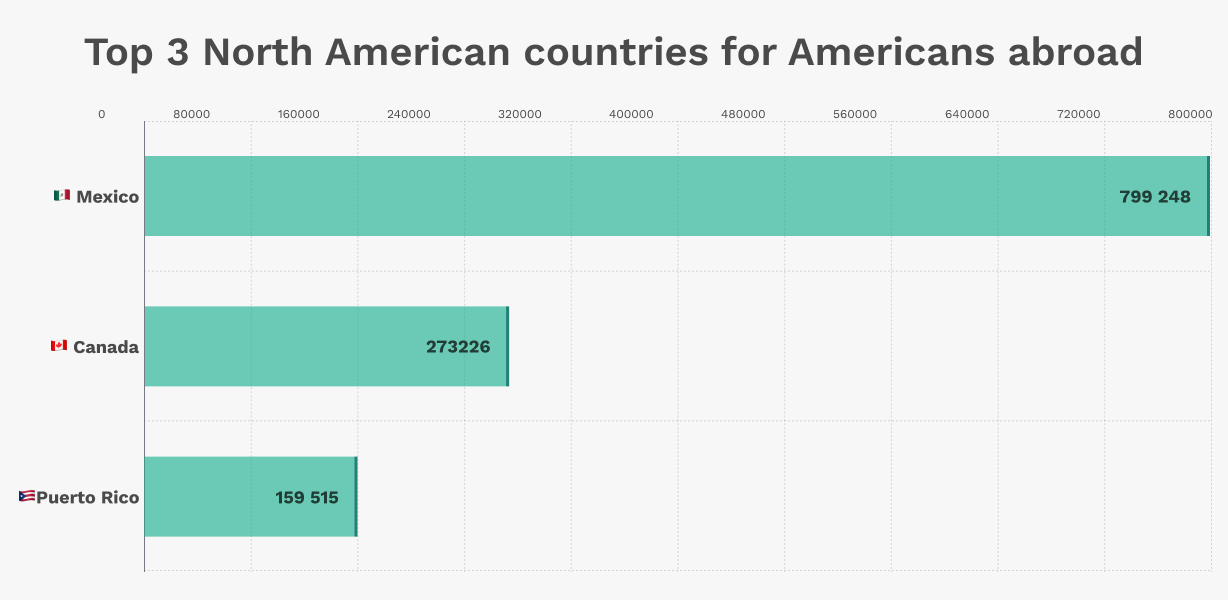
- Mexico (799,248 Americans)
- Canada (273,226 Americans)
- Puerto Rico (159,515 Americans)
Top 10 European Countries
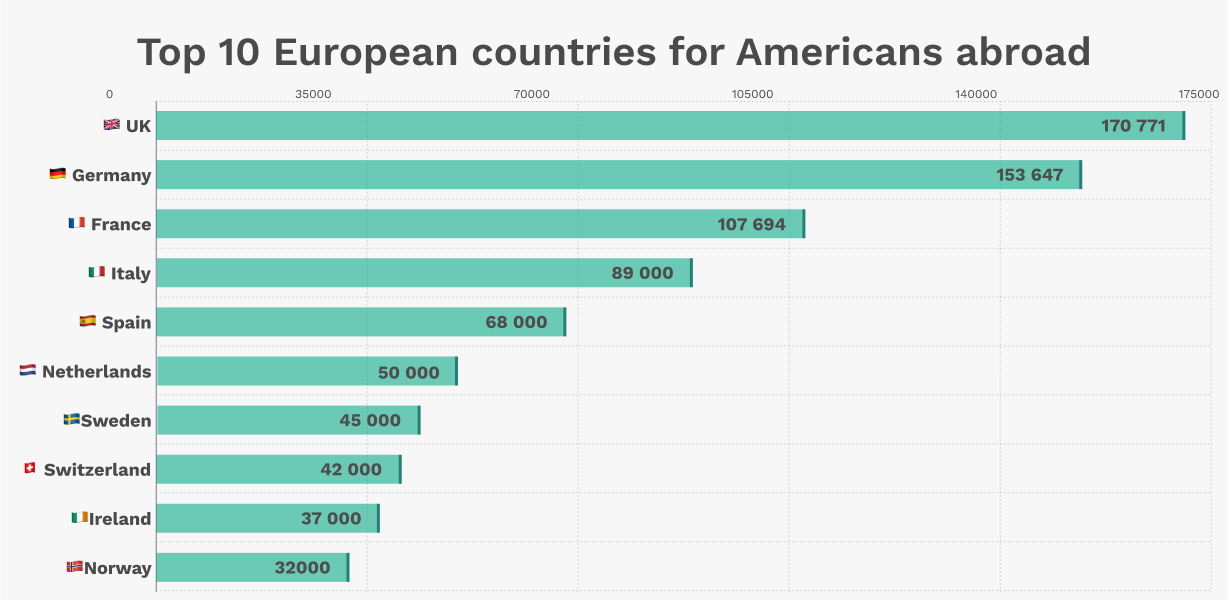
- United Kingdom (170,771 Americans)
- Germany (153,647 Americans)
- France (107,694 Americans)
- Italy (89,000 Americans)
- Spain (68,000 Americans)
- Netherlands (50,000 Americans)
- Sweden (45,000 Americans)
- Switzerland (42,000 Americans)
- Ireland (37,000 Americans)
- Norway (32,000 Americans)
Top 10 Asian Countries
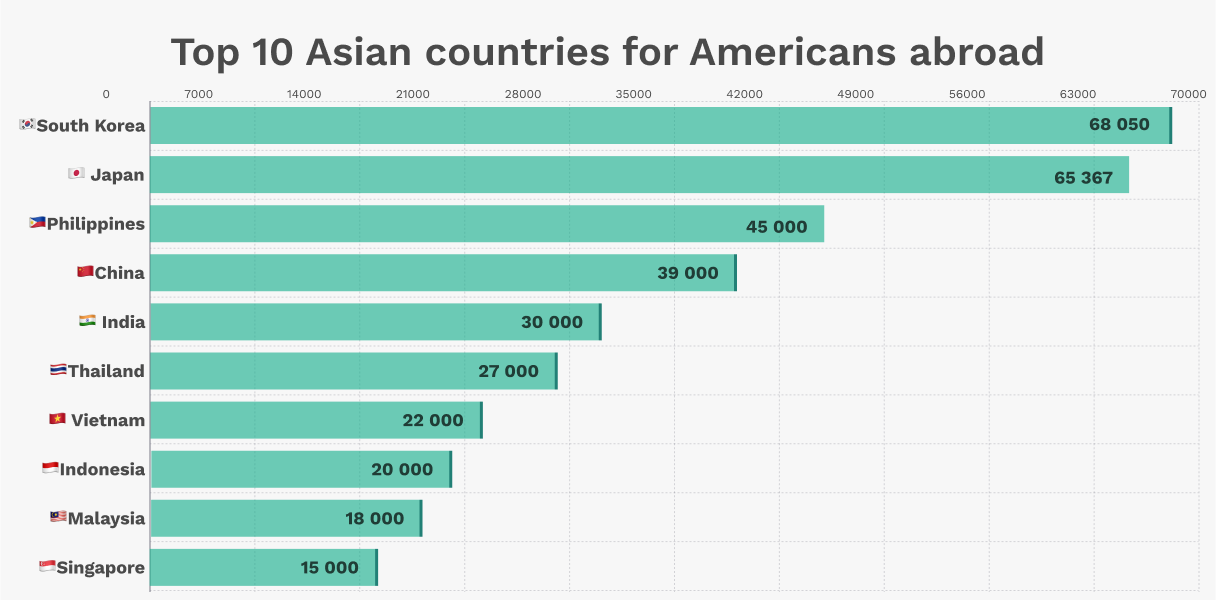
- South Korea (68,050 Americans)
- Japan (65,367 Americans)
- Philippines (45,000 Americans)
- China (39,000 Americans)
- India (30,000 Americans)
- Thailand (27,000 Americans)
- Vietnam (22,000 Americans)
- Indonesia (20,000 Americans)
- Malaysia (18,000 Americans)
- Singapore (15,000 Americans)
Top 10 Middle Eastern Countries
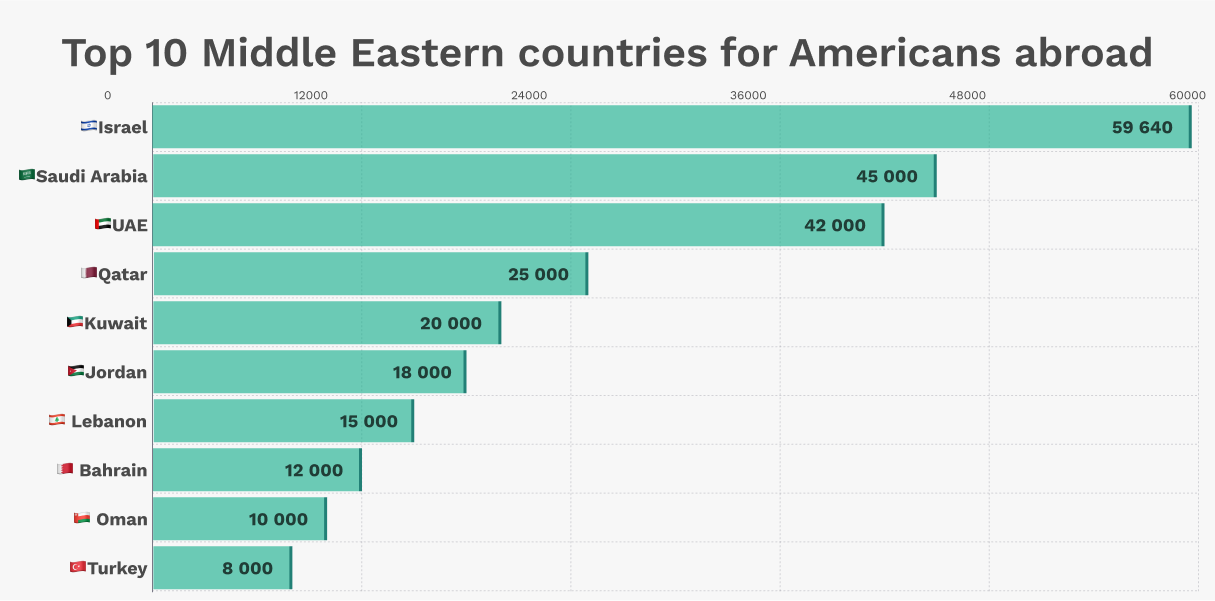
- Israel (59,640 Americans)
- Saudi Arabia (45,000 Americans)
- United Arab Emirates (42,000 Americans)
- Qatar (25,000 Americans)
- Kuwait (20,000 Americans)
- Jordan (18,000 Americans)
- Lebanon (15,000 Americans)
- Bahrain (12,000 Americans)
- Oman (10,000 Americans)
- Turkey (8,000 Americans)
Top 10 South American Countries
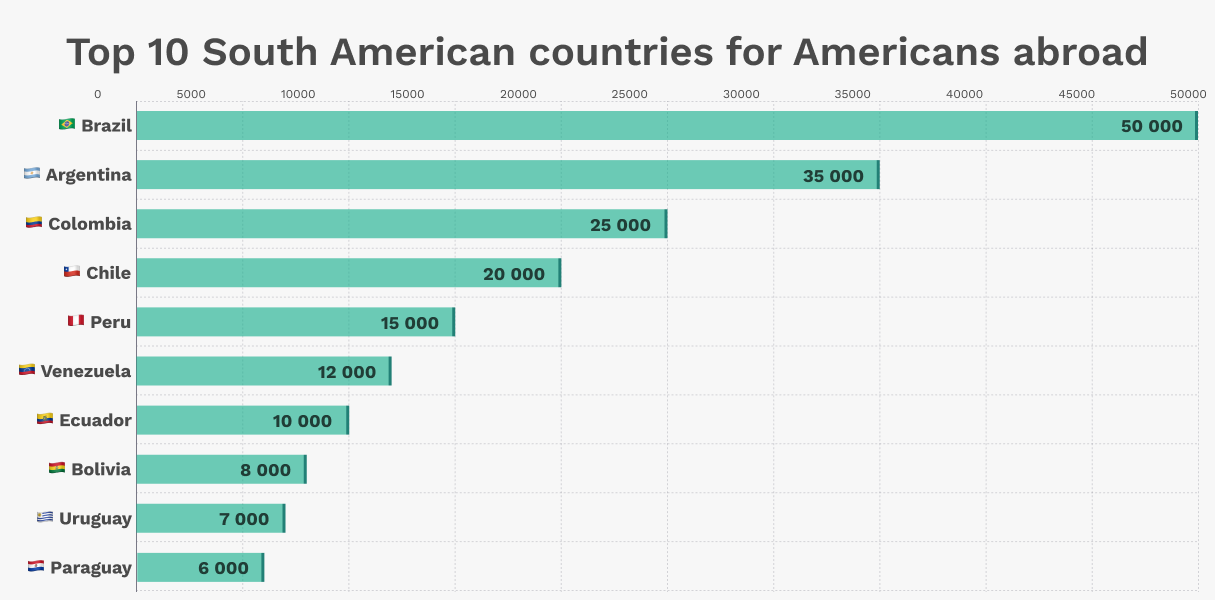
- Brazil (50,000 Americans)
- Argentina (35,000 Americans)
- Colombia (25,000 Americans)
- Chile (20,000 Americans)
- Peru (15,000 Americans)
- Venezuela (12,000 Americans)
- Ecuador (10,000 Americans)
- Bolivia (8,000 Americans)
- Uruguay (7,000 Americans)
- Paraguay (6,000 Americans)
Top 6 Oceanian Countries
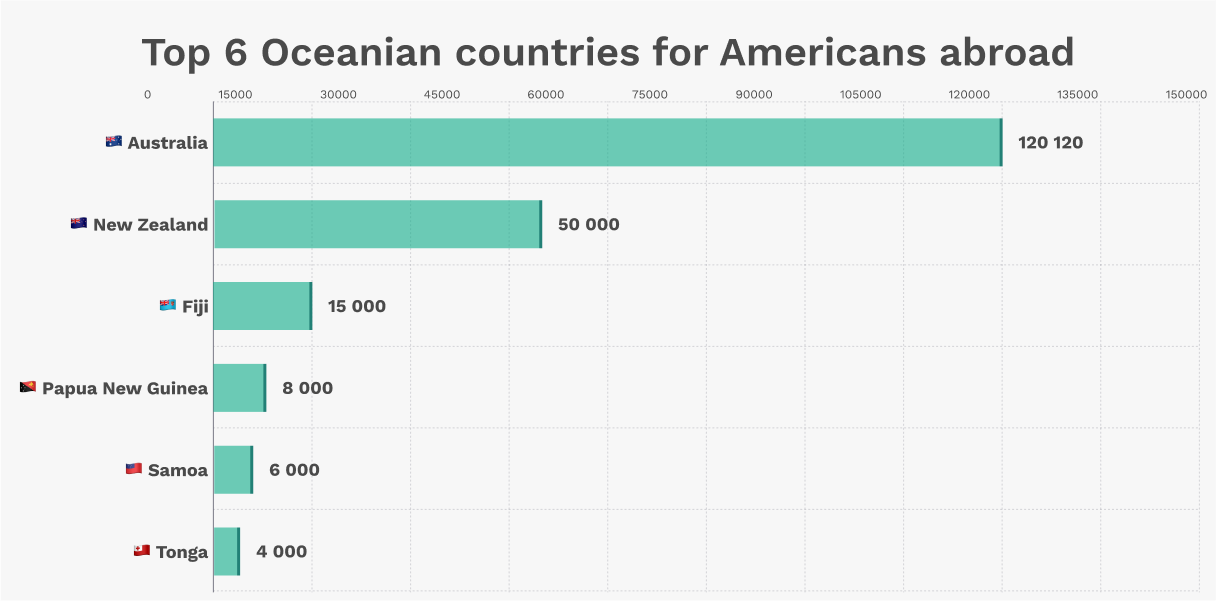
- Australia (120,120 Americans)
- New Zealand (50,000 Americans)
- Fiji (15,000 Americans)
- Papua New Guinea (8,000 Americans)
- Samoa (6,000 Americans)
- Tonga (4,000 Americans)
Top 5 African Countries
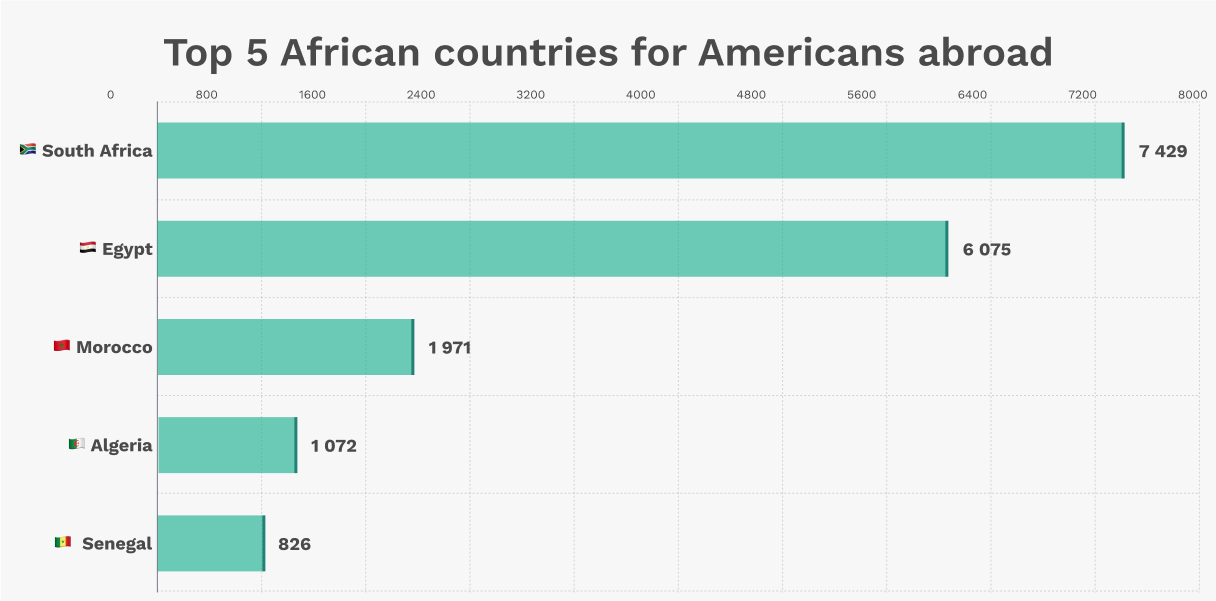
- South Africa (7,429 Americans)
- Egypt (6,075 Americans)
- Morocco (1,971 Americans)
- Algeria (1,072 Americans)
- Senegal (826 Americans)
Top 10 Caribbean Countries
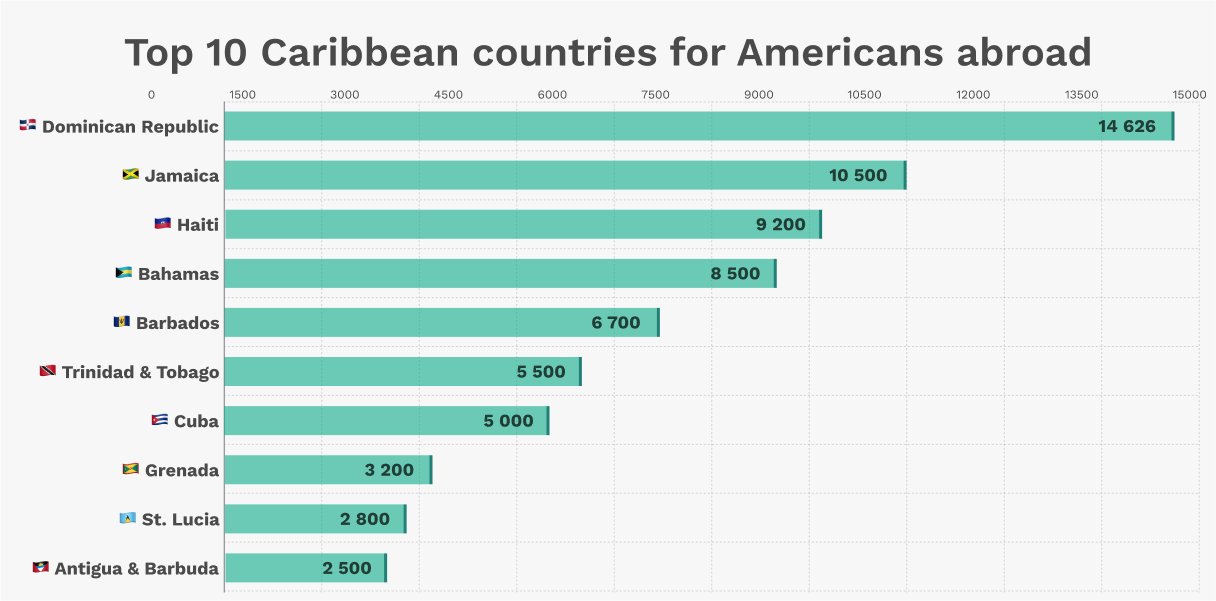
- Dominican Republic (14,626 Americans)
- Jamaica (10,500 Americans)
- Haiti (9,200 Americans)
- Bahamas (8,500 Americans)
- Barbados (6,700 Americans)
- Trinidad and Tobago (5,500 Americans)
- Cuba (5,000 Americans)
- Grenada (3,200 Americans)
- Saint Lucia (2,800 Americans)
- Antigua and Barbuda (2,500 Americans)
Reasons for living abroad
The decision for Americans to relocate abroad is influenced by a variety of factors, each contributing uniquely to the choice to emigrate.
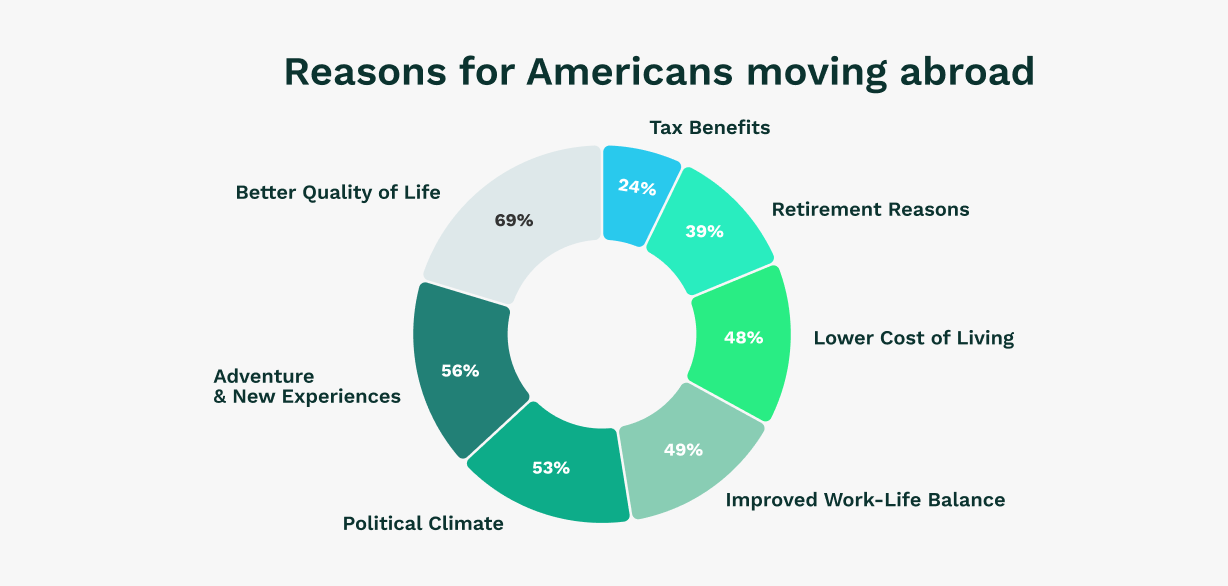
- Better Quality of Life – 69% of American expats cited this as the primary reason for moving abroad.
- Adventure & New Experiences – 56% moved abroad for cultural exploration and new experiences.
- Improved Work-Life Balance – 49% relocated to achieve a better balance between work and personal life.
- Political Climate – 53% of expats who moved in the last year cited political reasons.
- Lower Cost of Living – 48% moved to countries with lower living expenses.
- Retirement Reasons – 39% of older expats cited retirement as a factor.
- Tax Benefits – 24% relocated to optimize taxes and reduce financial burdens.
Better quality of life
A significant 69% of surveyed U.S. expatriates cited the pursuit of a better quality of life as a primary reason for moving abroad. Factors contributing to this include improved healthcare, enhanced work-life balance, and access to superior education systems in host countries.
Adventure and new experiences
The desire for adventure and new experiences motivated 56% of respondents to relocate. The opportunity to immerse oneself in diverse cultures, languages, and traditions plays a crucial role in this decision-making process.
Improved work-life balance
Approximately 49% of American expatriates sought an improved work-life balance. Many countries offer more generous vacation policies, flexible working hours, and a greater emphasis on leisure, which appeal to those seeking a healthier balance between professional and personal life.
Political climate
Among newer expatriates (those living abroad for less than a year), 53% cited the U.S. political climate as a driving factor for their move. This trend was particularly pronounced among Millennials, with 40% expressing political considerations as a significant influence.
Educational opportunities
Educational pursuits were a key motivator for Gen Z expatriates, with 55% highlighting educational opportunities as a primary reason for moving abroad. Access to esteemed international universities, diverse academic programs, and language acquisition prospects are significant attractions.
Challenges faced by Americans abroad
Bureaucratic hurdles
Navigating the administrative requirements of both the United States and host countries can be daunting for expatriates. The Foreign Account Tax Compliance Act (FATCA) mandates that U.S. citizens report their foreign financial accounts, leading to additional paperwork and potential banking difficulties.
According to a 2022 survey, 28% of American expatriates had to file extra forms due to FATCA, and 6% encountered challenges with banking abroad as a result.
Tax obligations
The U.S. is one of the few countries that taxes its citizens regardless of their residence, leading to complex tax situations for expatriates. A 2024 survey revealed that nearly 1 in 3 U.S. expatriates are considering renouncing their citizenship, with 75% citing the burden of tax obligations as a primary reason.
Cultural differences & integration
Adjusting to a new culture poses significant challenges. A qualitative study highlighted issues such as language barriers, differing social norms, and unfamiliarity with local customs as primary obstacles for expatriates. Participants emphasized the importance of social support and openness to new experiences in facilitating cultural adjustment.
Healthcare & insurance
Accessing healthcare services and understanding insurance systems in a foreign country can be complex. Expatriates often face challenges in finding providers, understanding coverage options, and dealing with potential language barriers within medical contexts.
Isolation & homesickness
Feelings of isolation and homesickness are common among expatriates. Being away from familiar support networks can lead to loneliness and mental health challenges. Building new social connections and finding community support are crucial for mitigating these feelings.



